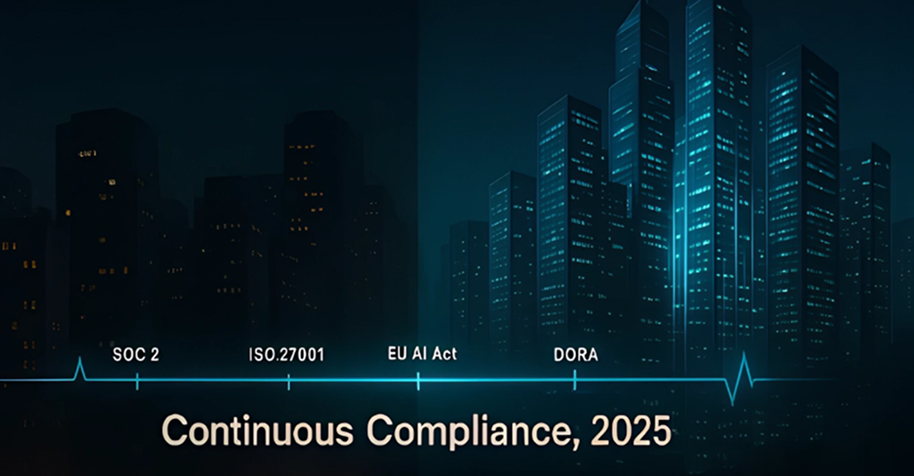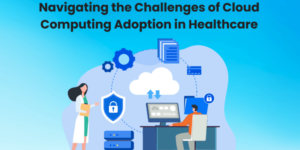
Cloud sprawl meets ever-stricter regulation every day. In 2023, the U.S. Securities and Exchange Commission (SEC) collected $4.949 billion in financial remedies. To stay trusted, you need a continuous-compliance platform that pulls evidence directly from AWS, Azure, and your DevOps pipelines, then maps it to SOC 2, ISO 27001, and other frameworks. For example, monitors your controls 24×7 and replaces frantic PDF hunts with real-time dashboards. This guide shows why the shift matters and walks you through a six-step checklist for choosing the right cloud GRC tool.
2025 GRC landscape: why continuous compliance is non-negotiable
New SEC cybersecurity rules, effective December 18, 2023, give public companies only four business days to disclose a material cyber incident and to show board-level oversight in every annual report. That tight window turns “audit season” into a year-round sprint to prove your controls work.
Europe is moving just as fast. The EU AI Act took effect on August 1, 2024; unacceptable-risk provisions start on February 2, 2025, and rules for general-purpose AI models follow on August 2, 2025. Auditors already lean on ISO/IEC 42001 (published December 2023) for AI-governance audits, while the Digital Operational Resilience Act (DORA) became fully applicable on January 17, 2025, with steep penalties for ICT failures across twenty financial-sector entities.
Cloud estates keep growing. The average company uses 130 SaaS apps. Add multiple AWS and Azure accounts, and the log volume soon overwhelms any spreadsheet; one public S3 bucket or orphaned API key can wipe out brand equity overnight.
Continuous controls monitoring resolves that risk. Modern platforms such as Vanta’s continuous GRC solution pull evidence from cloud APIs, cross-map controls across 27 frameworks, and flag drift 24×7 before auditors or attackers can act.Because everyone sees the same live dashboard, legal, engineering, and risk teams drop week-old PDFs and fix issues while they’re still small.
Security buyers hold vendors to the same bar. If a platform stores production evidence, you expect a current SOC 2 Type II or ISO 27001 certificate plus granular, role-based access logs. In 2025, vendors that cannot prove their own compliance rarely make your shortlist.
Continuous compliance is no longer a buzzword; it is the entry fee for doing business in the cloud.
Evaluation checklist: choosing the right cloud GRC platform

You wouldn’t buy a car without a test drive, and you shouldn’t choose GRC software on a glossy demo. Walk through six checkpoints to tell real automation from shelfware.
Step 1: Clarify your compliance requirements and goals
Begin with a facts-first inventory. List every obligation SOC 2 for customers, ISO 27001 for information security, GDPR for privacy, and ISO 42001 if you ship AI features. A significant number of security leaders now map controls to multiple frameworks at once, so a clear list stops scope creep before it starts.
Next, translate those obligations into jobs to be done. Are you racing to finish a first-time SOC 2 audit, centralizing third-party risk, or preparing DORA board reports? A startup that sells to enterprises needs evidence automation now, while a regional bank must surface risk heat maps for regulators. Different jobs call for different features.
Finally, attach a metric to each goal. Case studies for GRC platforms show automated evidence collection can significantly cut audit prep time, so decide whether you aim for a similar reduction or, perhaps, freeing one day a week for proactive security work. Write these targets in a shared doc; every later decision capabilities, integrations, budget should trace back to this baseline. If a platform cannot support the list, move on quickly.
Step 2: Assess core GRC capabilities
Now that you have defined success, test whether each platform delivers. Start with the three pillars: policies, risks, and controls. Can you store every policy in a single library, assign an owner, and track attestations without exporting a spreadsheet? When you log a new risk, does the system connect it to a mitigating control in seconds, or does that link hide three menus deep?
Next, open the dashboard. Teams that adopt real-time compliance dashboards often report significant improvements in decision-making speed, a reduction in compliance incidents, and faster spotting of red-flag controls. If you cannot answer Which SOC 2 controls failed last week? at a glance, the tool is not built for continuous compliance.
Finally, follow an issue from alert to closure. Drag-and-drop assignment, native notifications, and a tamper-proof audit trail should turn findings into finished tasks without an email chase. Workflow ease matters: Companies have reported cutting administrative hours by a significant margin after moving to an integrated GRC workspace. If the demo forces clunky status updates, user adoption will stall in production.
Capability beats cosmetics; choose the platform that makes these journeys effortless.
Step 3: Verify integration and automation
Your GRC platform lives or dies by its connectors. Leading GRC platforms list hundreds of pre-built integrations, spanning cloud providers, DevOps tools, and HR systems. This breadth allows teams to automate a substantial portion of evidence collection.
When a vendor offers only a handful of connectors, spreadsheets creep back in.
Look beyond cloud accounts. Controls increasingly live in code, so the platform should plug into GitHub or GitLab to confirm that every pull request gets a security review, then open a Jira or ServiceNow ticket the moment a check fails. A large majority of DevOps teams rely on tools like Jira for their daily work, so seamless integration routes compliance alerts into an engineer’s natural workflow rather than yet another inbox.
Insist on an open, well-documented REST or GraphQL API. Your stack will change next quarter—maybe a new data warehouse or AI-safety tool—and closed systems age quickly. An API lets you connect niche evidence sources or build custom bots without waiting for the vendor’s roadmap, keeping compliance aligned with engineering velocity.
Step 4: Evaluate user experience and collaboration
A feature-rich tool that people ignore is worse than no tool at all. User adoption is a critical factor for new software, with many employees expressing frustration with non-intuitive tools. Ask yourself: can a non-technical policy owner find and sign an attestation in under ten minutes? Look for plain-language labels, helpful tooltips, role-based dashboards, and a tidy interface that hides noise.
Collaboration is the next pillar. Compliance spans Security, DevOps, HR, and external auditors. Platforms that embed @mentions, Slack or Teams alerts, and one-click task assignment can cut email threads dramatically. In one Hyperproof case study, a SaaS firm cut auditor response time in half after moving conversations into a shared audit portal. Recreate that flow in the sandbox: invite an auditor and watch how easily they pull evidence without your team acting as a middle-person.
Finally, confirm access controls. Executives should view board-level dashboards while sensitive evidence stays shielded from casual viewers. If the demo cannot show you how to lock a single folder or trace every download, keep looking.
Step 5: Confirm scalability, security, and maintenance
Growth sneaks up fast. Today you track two cloud accounts and one standard; next quarter an acquisition may add five hundred employees and PCI DSS to your list. Choose a GRC platform whose pricing scales predictably and whose dashboards still load quickly when you monitor tens of thousands of assets.
Security counts even more. While a relatively small percentage of SaaS vendors hold both SOC 2 and ISO 27001 certifications, these certified tools attract a disproportionately large share of enterprise spending. Ask each vendor for its latest SOC 2 Type II or ISO 27001 report and a recent penetration-test summary. If they hesitate, walk away; a tool that stores production evidence must model the rigor it demands from you.
Finally, inspect release cadence. High-performing engineering teams now deploy new code multiple times a day, proving that frequent, zero-downtime updates are the new standard. Confirm how quickly the vendor ships new control content when frameworks change and whether updates ever break custom mappings. Continuous compliance only works when the software itself stays continuously current.
Step 6: Calculate total cost and ROI
Price sheets rarely tell the whole story, so look at three layers of spend.
- Consider both subscription and implementation expenses in your budgeting. Request detailed breakdowns from vendors on whether they charge per user, per asset, per framework, or via a blended approach, and model those costs against your two-year growth projections. For organizations pursuing multi-site ISO 27001 certification, proven tactics like pooled sampling and consolidated documentation can cut audit spend by as much as 40 percent. Finally, factor in onboarding: Industry analysts report that implementation services can be a significant portion of the first-year license fees, so be sure to clarify who covers these charges and what the expected timeline looks like.
- Cost of inaction: IBM’s 2023 Cost of a Data Breach Report pegged the average incident at $4.45 million.Research from the Ponemon Institute has found that the cost of non-compliance is 2.71 times higher than the cost of compliance.Treat these numbers as the shadow price of skipping automation or delaying audits.
- Hard and soft payback Automation is more than nicer dashboards. Case studies for GRC platforms show teams can reclaim a significant percentage of audit-prep hours by eliminating manual evidence collection. Those hours flow back into product work or sales cycles. Every week you shave from an audit can pull enterprise revenue forward, often by a full quarter.
Build a simple ROI sheet: annual licence plus services versus hours saved, lower breach probability, and accelerated bookings. If the math does not balance within eighteen months, keep negotiating or keep looking.
Snapshot comparison: representative cloud GRC platforms in 2025
| Platform | Core differentiator | Deployment and time to value | Best-fit scenario |
|---|---|---|---|
| Vanta | Automation focus, offering 375 pre-built integrations and continuous evidence collection | SaaS; audit-ready in 2–4 weeks for SOC 2 or ISO 27001 | High-growth tech firms that value speed and live dashboards |
| RSA Archer IRM | Deep Process Builder with more than 1,000 pre-made risk records | On-prem or hosted; typical roll-out 9–12 months for large enterprises | Highly regulated Fortune 500 organizations that need extreme configurability and have a dedicated GRC team |
| ServiceNow GRC | Native link to CMDB and ITSM workflows already used by seven in ten IT teams | SaaS; ITSM customers add GRC in 3–6 months by extending an existing instance | Firms that already run ServiceNow for IT operations and want risk data inside the same platform |
| OneTrust GRC | Broad privacy and ESG library with more than 300 templates across security, privacy, and ethics | SaaS; template-driven setup in 4–8 weeks | Companies that need one hub for privacy and security controls without heavy custom code |
| LogicGate Risk Cloud | Low-code builder lets teams create custom workflows without developers | SaaS; phased roll-outs in 6–12 weeks depending on app count | Mid-size enterprises that need tailored processes without a heavyweight IRM suite |
| Hyperproof | Supports 115 compliance frameworks, more than its top three competitors combined | SaaS; customers report reaching audit readiness 30–40 percent faster than with spreadsheets | Organisations juggling many certifications that want continuous reminders and clear ownership |
How to use this table:
Match your must-have criteria from the six-step checklist. If rapid automation tops the list, look at Hyperproof. If deep custom processes matter, Archer or LogicGate may shine. Treat the stats as conversation starters and ask each vendor to prove how the numbers apply to your environment and growth plans.
Avoiding pitfalls: common mistakes when implementing cloud GRC

Even the best platform can fail if the rollout stumbles. Watch for these four traps:
- Buying on buzzwords instead of fit: A flashy demo that name-drops AI and blockchain may look exciting, yet a common reason for GRC implementation failure is a misalignment between the tool and the organization’s daily workflows. Keep your six-step checklist handy and make vendors prove how each feature solves your use cases.
- Skipping stakeholder alignment: Change management, not technology, kills projects. McKinsey research shows 70 percent of transformations fail when leaders do not secure cross-functional buy-in. Pull Security, Engineering, Legal, HR, and Audit into discovery and training to keep data flowing.
- Letting scope creep run wild: The Project Management Institute has found that uncontrolled scope changes are a major driver of project budget overruns. Start with a minimum viable scope perhaps SOC 2 controls and vendor risk then add modules only after the team masters the basics.
- Treating the platform as “set and forget” Controls drift if no one tends the garden. Assign a platform owner to review dashboards weekly and update mappings when frameworks evolve. Without that gardener, even automated tests grow weeds, risking surprise audit gaps and eroding trust.






